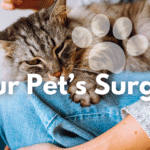Pets bring endless joy into our lives, and as their guardians, it’s our responsibility to ensure they’re happy and healthy. Beyond cuddles and playtime, pet wellbeing requires attention to their physical, mental, and emotional needs. Whether you’re a seasoned dog parent, a devoted cat lover, or just brought home your first rescue, this guide will equip you with ten essential ways to keep your furry companions thriving.
1. Nutritious Diet: Fueling Happiness and Health
What your pet eats is the foundation of their overall health. A balanced diet tailored to your pet’s specific needs promotes longevity, energy, and happiness. But what does a “nutritious diet” entail?
- Choose high-quality food: Consult THE VET ON MAIN about well-reviewed, age-appropriate pet food brands.
- Stick to portion sizes: A veterinarian can help you determine the right portion sizes, as overfeeding can lead to weight gain and health problems.
- Provide fresh water daily: Always ensure your pet has access to clean, fresh water.
2. Regular Exercise: Keeping Them Active
Exercise not only keeps pets fit but also enriches their mental health by reducing boredom and anxiety.
- Dogs need daily walks, fetch, or even advanced activities like agility classes.
- Cats enjoy games with pole toys, feather toys, or climbing trees.
The trick is to find activities that work for your pet’s age and energy levels. Pet care professionals recommend consulting TVOM to tailor an exercise regimen for your companion.
3. Mental Stimulation: Engaging Their Minds
Physical health is only one piece of the puzzle. Mental enrichment supports your pet’s happiness and reduces behavioral issues.
- Try puzzle feeders or interactive toys to challenge their problem-solving skills.
- Rotate toys weekly to keep excitement levels high.
- For dogs, consider enrolling them in training classes to stimulate their brains and strengthen your bond.
Pro tip: If your pet seems disinterested or lethargic, speak to THE VET ON MAIN about their mental and emotional health.
4. Regular Vet Check-ups: Preventing Health Issues
Prevention is always better than cure. During vet visits, key areas to cover include:
- Pet vaccinations to protect against diseases.
- Annual wellness exams to detect potential issues early.
- Parasite prevention for fleas, ticks, and heartworms.
Investing in reliable veterinary services saves you from unexpected trips to the emergency vet and keeps your furry friend thriving.
5. Grooming: Looking Good, Feeling Good
Proper grooming isn’t just about appearances; it also ensures good hygiene and health. Each pet’s grooming needs will differ, but here are a few essentials:
- Brush your pet to reduce shedding and maintain a coat’s shine.
- Bath them regularly (but not too often). Use shampoos designed for pets to avoid irritation.
- Trim your dog’s nails or visit a GROOMER for help if you’re unsure.
- Brush their teeth! Dental health is often overlooked, but crucial for preventing oral diseases.
If your pet’s hair becomes matted or their claws too long, consult a GROOMER equipped with pet grooming services.
6. Safe Environment: Protecting Them from Harm
Providing a safe living space helps promote both their physical and emotional wellbeing. Keep these guidelines in mind:
- Ensure your home is free of choking hazards like small toys or loose wires.
- Store toxic foods and cleaning products out of reach.
- For cats, secure windows and provide safe spaces for them to perch.
- Microchip your pet as an added layer of security in case they get lost.
7. Socialization: Building Confidence and Comfort
Socializing your pet is key to reducing aggression and anxiety. Dogs, in particular, thrive in social environments but even cats benefit from building connections with humans and other animals.
- Arrange playdates with other pets.
- Introduce them to strangers gradually.
- Visit spaces they can explore safely, like dog parks or pet-friendly cafes.
If your pet shows fear or nervousness in social settings, reach out to a Trainer or Behavior Specialist to rule out any underlying issues.
8. Showing Affection: Strengthening Your Bond
Hugs, cuddles, and one-on-one time are essential for creating a strong bond with your pet. But showing affection also goes beyond physical touch:
- Speak lovingly to them, using positive reinforcement for good behavior.
- Spend quality time watching TV together or relaxing in a shared space.
- Be patient! Gentle, consistent interactions build trust, especially for rescues adapting to a new home.
Sometimes, subtle behaviors (like a wagging tail or nuzzling) are your pet’s way of saying “I love you.” Give them the affection they deserve!
9. Emergency Response Preparedness
Having a plan for emergencies can save both you and your pet unnecessary stress. Start by saving the contact information of an emergency vet or 24-hour animal hospital in your area for quick access. Additionally:
- Keep a first-aid kit tailored for pets at home.
- Learn basic first-aid techniques to stabilize injuries before professional help is available.
- Regularly check for signs of illnesses, like changes in eating behavior or unusual lethargy, and act promptly by contacting The Vet On Main.
10. A Happy Pet Makes a Happy Home
By taking these steps, you create a nurturing environment where your furry friend can flourish. From regular vet check-ups through trusted veterinary services, to simple acts of affection, each small effort you make contributes to a healthier, happier pet.
If you’re ready to elevate your pet care routine, visit our online pet store for premium products, toys, and treats handpicked by pet care experts. Your companion will thank you with all the tail wags and purrs you could ask for.
Let’s create a happier home, one wag and meow at a time!






